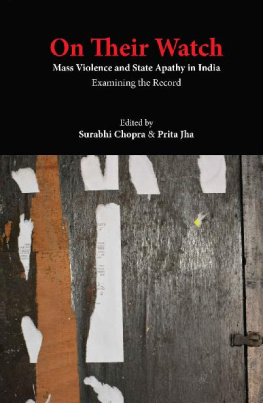Praise for the book
k
On Their Watch shows the enormity of the wrongs that have been done in India to the victims of mass violence as state authorities failed to ensure elementary standards of justice, accountability or rehabilitation. It is a powerful example of how the Right to Information Act can be used to lay bare the structures of power and oppression. This is a model of research for action.
Jean Drze, Honorary Professor, Delhi School of Economics On Their Watch is a clinical study of the signal failure of the Indian State to provide justice to the victims of mass communal violence.
It pierces through the miasma of silence and secrecy to excavate public records, the transcripts of the State, as it were, to make a powerful indictment of the State. This is social forensics at its finest.
Manisha Sethi, Fellow, Nehru Memorial Museum and Library On Their Watch is a comprehensive assessment of the response of the state to mass violence and genocide as well as a fascinating practical guide on how to use the RTI Act to extract sensitive information from a recalcitrant bureaucracy. A must-read for those who want to understand why and how the state is apathetic to victims of mass violence, and for those who want to use the RTI Act as a research instrument.
Shekhar Singh, National Campaign for Peoples Right to Information Communal, targeted violence has been the bane of Indian society.
The core point of violence is the failure of state apparatus to contain it and punish the guilty. This well researched book gives us an insight into the phenomenon of the failure of the state to curb this menace.
Ram Puniyani, Centre for Study of Society and Secularism
iid
On Their WaTch
This seminal work makes it amply clear that the primary objective of transparency namely, establishing accountability of the Government and its instrumentalities to the governed, is a far cry in the worlds largest democracy. As the RTI Act enters the 10th year of implementation, its success needs to be measured in terms of peoples ability to access quick, inexpensive and effective justice besides ration cards and passports. An eye-opener for anyone who thought India had established a regime of transparency in 2005.
Venkatesh Nayak, RTI activist, New Delhi In my opinion this is the first well documented study focusing on the role of the state in mass violence. It provides undisputed evidence to show that the Indian State irrespective of political party in power has failed in its primary responsibility of protecting citizens from communal, mass-scale violence and in providing justice as well as material and non-material restitution to the victims The volume is very useful manual to Human Rights-RTI activists as well as to those scholars and students of of law and social science who wish to analyse the nature of Indian state.
Ghanshyam Shah, National Fellow, Indian Institute of Advanced Study k
Preface ciii
On Their Watch

On Their Watch
Mass violence and State apathy in India Examining the record
Edited by
Surabhi Chopra & Prita Jha

First Edition October 2014
copyrightCentre for Equity Studies & Three Essays Collective, 2014
All rights reserved
No part of this book may be reproduced or utilised in any form or by any means, electronic or mechanical, including photocopying, recording or by any information storage or retrieval system, without the prior written permission of the publisher.
ISBN 978-81-88789-87-0
Produced in association with Centre for Equity Studies, New Delhi B-957 Palam Vihar, GURGAON 122 017 India
Phone: 91-124 2369023, +91 98681 26587
info@threeessays.com Website: www.threeessays.com Printed and bound at Chaman Offset Printers, New Delhi
Contents
Preface xi
Contributors xvii
Acknowledgements xix
1. Introduction
Part I
Extracting State Records
2. Exercising the Right to Information
Part II
Four Episodes of Mass Violence
3. Nellie 1983
4. Delhi 1984
5. Bhagalpur 1989
6. Gujarat 2002
Part III
Examining the States Record
7. Access to Criminal Justice
8. Holding Public Officials Accountable
9. Relief, Compensation and Rehabilitation 311
10. Conclusion
Appendix: Battling a Corrosive Menace
Index 365
We dedicate this book to victims and survivors of mass violence in India, and to the memory of Ram Narayan Kumar, who worked with such
commitment to challenge impunity for human rights abuses.
Preface
Contemporary India has a troubled history of sporadic blood-letting in gruesome episodes of mass violence which targets men, women and sometimes children because of their religious identity. The Indian Constitution unequivocally guarantees equal legal rights, equal protection and security to religious minorities. However, the Indian States record of actually upholding the assurances in the secular democratic Constitution has been mixed. This study tries to map, understand and evaluate how effectively the State in free India has secured justice for victims of mass communal violence. It does so by relying primarily on the States own records relating to four major episodes of mass communal violence, using the powerful democratic instrument of the Right to Information Act, 2005. In this way, it tries to hold up the mirror to governments, public authorities and institutions, to human rights workers and to survivors themselves.
Since Independence, India has seen scores of group attacks on people targeted because of their religious identity.1 Such violence is described in South Asia as communal violence. While there is insufficient rigorous research on numbers of people killed in religious massacres, one estimate suggests that 25,628 lives have been lost (including 1005 in police firings).2 The media has regularly reported on this 1 A.A. Engineer, Communal Riots after Independence: A ComprehensiveAccount (Delhi: Shipra, 2004).
2 B. Rajeshwari, Communal Riots in India: A Chronology ( 1947-2003) (Delhi: Institute of Peace and Conflict Studies, 2004).
xiid
On Their WaTch
violence, citizens groups have documented grave abuses and State complicity in violence, and government-appointed commissions of inquiry have gathered extensive evidence on it from victims, perpetrators and officials. Despite this, it has been remarkably difficult to hold perpetrators and State authorities accountable for committing, encouraging, aiding or enabling (including through deliberate inaction) such violence.
Many of those who engaged in the research underlying this book have experience of working directly with survivors of mass communal violence, and learning from the narratives and experience of victim survivors. There is also a fairly large body of information
reports of judicial commissions, investigations by civil rights groups, academic research and journalism available on episodes of mass communal violence. All of these suggest a recurring pattern of structural injustice and impunity leading up to, during and in the aftermath of such mass violence.
This book does not investigate the build-up and prevention of episodes of mass communal violence. It focuses on the access of victims to protection, justice and reparation after communal violence. In summary the books hypothesis is that the Indian State has failed, in very large measure, to prosecute perpetrators, to account for its own failures, to compensate victims, and to tell citizens about what it did or did not do after episodes of mass violence. This book seeks to examine this hypothesis, by excavating the States own records.
Next page










